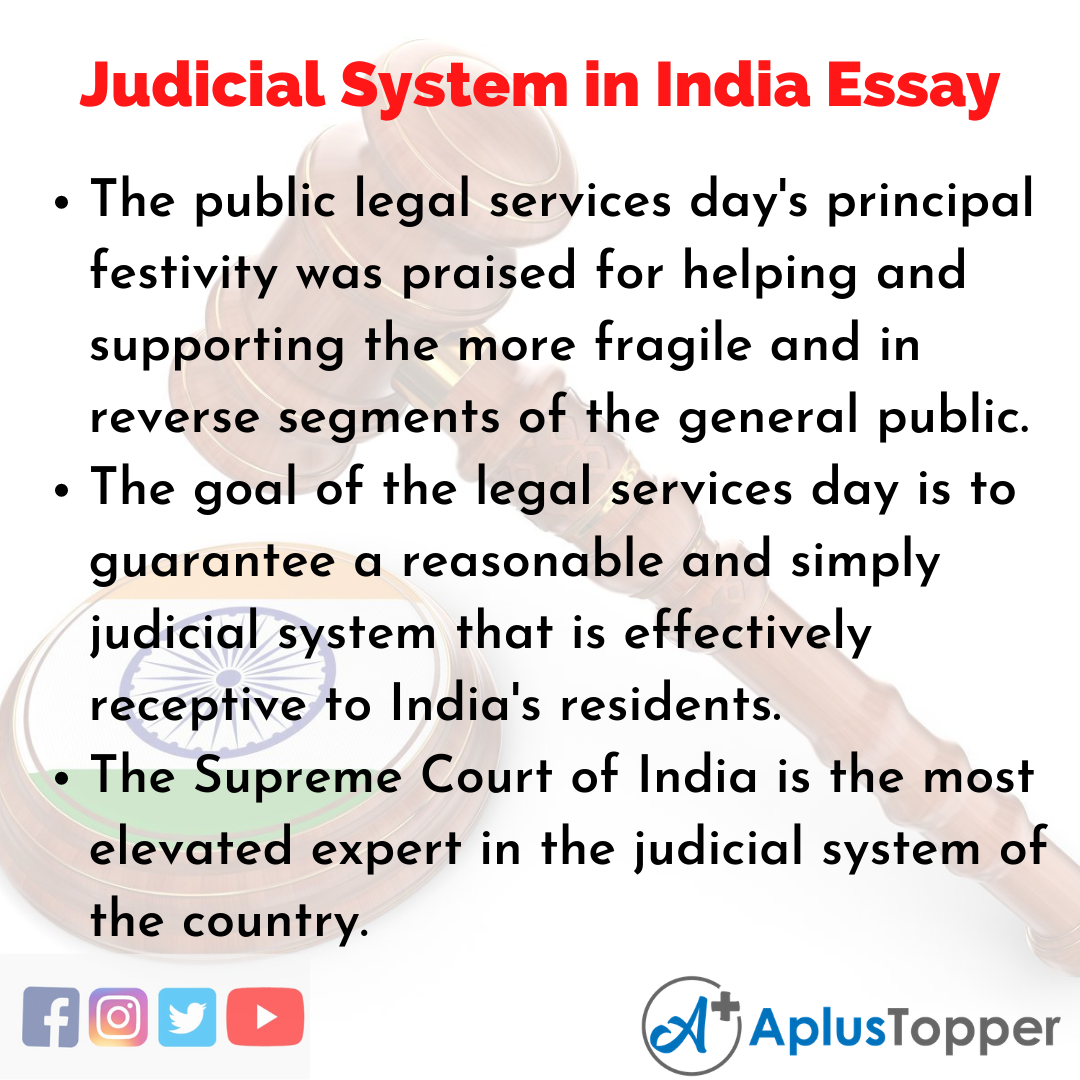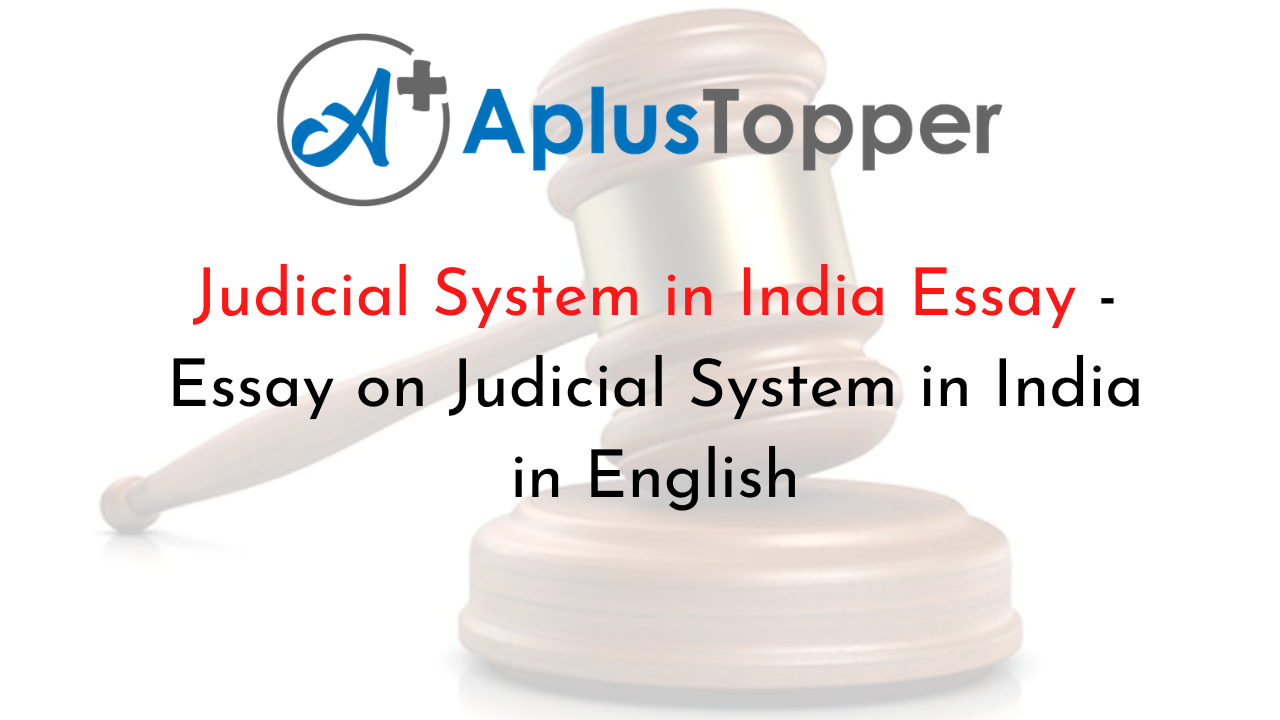Judicial System in India Essay: The Judiciary system of Bharat is law and rules express for citizens’ government assistance. It’s responsible for affirming and re-authorize the law and request. Judicial System or the court system is furthermore the Judiciary System. The court has the office to make choices, and conjointly implement the law, tackle debates.
The legal executive system comprises Judges and elective justices; they type the seat or the centre legal executive system’s centre. Under the constitution of Bharat, the Supreme Court is that the final court of appeal. Subsequently has the law specialist of Bharat, just as thirty appointed authorities and elective adjudicators for consultative purview.
You can read more Essay Writing about articles, events, people, sports, technology many more.
Long and Short Essays on Judicial System in India for Students and Kids in English
We are providing the students with essay samples on an extended essay Judicial System in India of 500 words and a short essay Judicial System in India of 150 words on the topic of Judicial System in India.
Long Essay on Judicial System in India of 500 Words in English
Long Essay on Judicial System in India is helpful to students of classes 7, 8, 9, 10, 11 and 12.
The Indian Judiciary works independently from the Executive and Legislative groups of the Indian government. It capacities at various levels. The Supreme Court is the pinnacle body, trailed by High Courts at the state level, locale courts at the area level and Lok Adalats at the town and panchayat level. The legal executive is answerable for maintaining law and request in the country.
It tackles issues brought about by common and criminal offences. The Indian judicial system is displayed on the British legal system that worked during the frontier period. Very few revisions have been made in the system since independence. The Supreme Court came into power on 28th January 1950; two days after the Indian Constitution happened.
The Supreme Court (SC) has numerous obligations and duties. It is the most noteworthy court of allure in the land and is likewise the constitution’s defender. The Supreme Court of India is comprised of the Chief Justice of India and 25 different adjudicators. The Chief Justice is likewise counselled for appointing the adjudicators of the Supreme Court. The Supreme Court judges have the opportunity to practice their force when required. An official request is an absolute necessity for the expulsion of the SC judges. Additionally, a 66% lion’s share must be obtained from both houses.
The SC’s locale is 3-overlay – original purview (in questions among government and states), warning ward and re-appraising ward. The SC can likewise authorize essential rights according to Article 32 of the Constitution of India. If a high court judgment isn’t agreeable, one can engage the SC. The SC can acknowledge or dismiss cases at its attentiveness. It can likewise absolve criminals and drop their life detainment or capital punishment. Here and there, the President of India alludes cases to the SC under Article 143 of the Constitution and the most elevated court at that point takes a choice on it.
The SC isn’t dependent upon outer controls. Hatred of court is a culpable offence. The high court judges are appointed by the President of India in counsel with India’s Chief Justice and the Governor of the state. The Chief Justice heads the high courts of India. The Indian judicial system is all things considered genuine and fair-minded in its dealings.
Yet, it isn’t safe to debasement. A significant disadvantage of the Indian judicial system is the time taken to discard cases. This itself is regularly commensurate to a forswearing of equity as cases delay courts until the disputants are no more. The most optimized plan of attack courts is now and again set up in exceptional cases to forestall this.
Another allegation about the legal executive is that it doesn’t stop for a second to invoke the scorn of court law at whatever point there is some analysis. Even though the Indian disdain law was corrected in 2006, making ‘truth’ a guard, in August 2007, columnists who worked for the Mid-Day paper were granted a sentence of detainment by the Delhi high court for sullying the picture of the Supreme Court. However, they argued ‘truth’ as a safeguard. Such incidents have driven a few groups to remark that the Indian legal executive appreciates unjustifiable advantages.

Short Essay on Judicial System in India 150 Words In English
Short Essay on Judicial System in India is helpful to students of classes 1, 2, 3, 4, 5 and 6.
Any legal executive is an integral piece of a country, particularly vote based system. As India is the biggest majority rule government, we have a major legal executive that ensures it shields its residents’ interests. Also, our Supreme Court is at the highest point of our executive legal system. It is then trailed by our high courts, which work at the state level. Further, area courts are operating at the regional level. There are additionally a lot more courts beneath this request.
A legal executive has numerous tasks to carry out. As a legal executive is independent of the leader, it can, without much of a stretch, protect the resident’s privileges to guarantee harmony and concordance. In any case, its job isn’t simply restricted to this. It assumes various parts to ensure there is smooth functioning in the country. Right off the bat, it assumes an extraordinary part in making new laws.
10 Lines on Judicial System in India Essay
- Public legal services day is commended on the ninth of November consistently.
- The goal of the legal services day is to guarantee a reasonable and simply judicial system that is effectively receptive to India’s residents.
- The Supreme Court of India is the most elevated expert in the judicial system of the country.
- In the year 1995, the Supreme Court of India initially commended the public legal services day.
- The public legal services day’s principal festivity was praised for helping and supporting the more fragile and in reverse segments of the general public.
- Providing free legal guide and counsel to individuals who can’t bear such services’ cost is one of the main goals of legal services experts in the country.
- It turns into the judicial system’s duty to make mindfulness of the different legal perspectives in the public arena among its public.
- Lok Adalats sorts out such missions consistently by the legal services expert on public legal services day.
- The elective debate goal system is advanced on public legal services day.
- Lok Adalat mediation and assuagement are a portion of the judicial system’s instruments for substitute debate goal. The significance of these apparatuses is advanced and make mindfulness about on public legal services day.

FAQ’s on Judicial System in India Essay
Question 1.
When is public legal service day celebrated in India?
Answer:
Public legal services day is praised on the ninth of November consistently.
Question 2.
What is the goal of public legal services day?
Answer:
The goal of public legal services is to give free and issue legal services to the more fragile segments of the general public and spread mindfulness about the significance of the legal executive in the country among the overall population.
